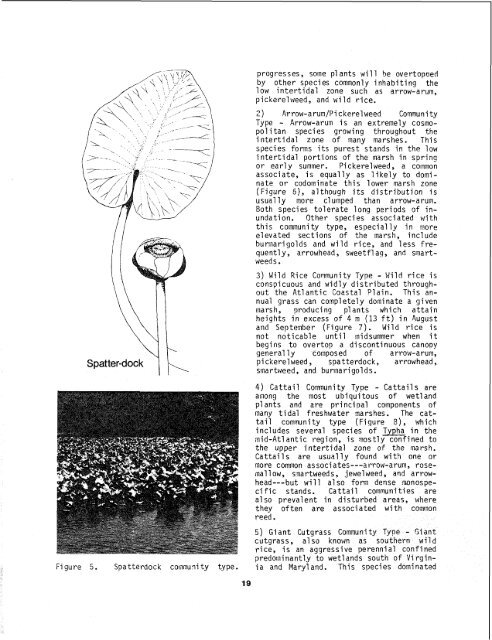The Ecology of Tidal Freshwater Marshes of the - USGS National ...
The Ecology of Tidal Freshwater Marshes of the - USGS National ...
The Ecology of Tidal Freshwater Marshes of the - USGS National ...
You also want an ePaper? Increase the reach of your titles
YUMPU automatically turns print PDFs into web optimized ePapers that Google loves.
progresses, some pl ants wi 11 be overtopaedby o<strong>the</strong>r species commonly inhabiting <strong>the</strong>low intertidal zone such as arrow-arum,pickerelweed, and wild rice.2) Arrow-arum1Pickerelweed CommunityType - Arrow-arum is an extremely cosmopoli tan species growing throughout <strong>the</strong>intertidal zone <strong>of</strong> many marshes. Thisspecies forms its purest stands in <strong>the</strong> lowintertidal portions <strong>of</strong> <strong>the</strong> marsh in springor early summer. Pickerelweed, a commonassociate, is equally as likely to dominateor codominate this lower marsh zone(Figure S), although its distribution isusual ly more cl unped than arrow-arum.Both species tolerate long periods <strong>of</strong> inundation.O<strong>the</strong>r species associated withthis community type, especially in moreelevated sections <strong>of</strong> <strong>the</strong> marsh, includeburrnarigolds and wild rice, and less frequently,arrowhead, sweetfl ag, and smartweeds.3) Wild Rice Community Type - Wild rice isconspicuous and widly distributed throughout<strong>the</strong> Atlantic Coastal Dlain. This annualgrass can completely dominate a givenmarsh, producing plants which attainheights in excess <strong>of</strong> 4 m (13 ft) in Augustand September (Figure 7). Wild rice isnot noticable until midsummer when itbegins to overtop a discontinuous canopygeneral ly composed <strong>of</strong> arrow-arum,pickerelweed , spatterdock, arrowhead,smartweed, and burnarigolds.4) Cattail Community Type - Cattails areamong <strong>the</strong> most ubiquitous <strong>of</strong> wetlandplants and are princioal components <strong>of</strong>many tidal freshwater marshes. <strong>The</strong> cattailcommunity type (Fiqure 8), whichincludes several species <strong>of</strong> Typha in <strong>the</strong>mid-Atlantic region, is qostly confined to<strong>the</strong> upper intertidal zone <strong>of</strong> <strong>the</strong> marsh.Cattails are usually found with one ormore common associates---arrow-arum, rosema11 ow, snartweeds, jewelweed, and arrowhead---butwill a1 so form dense inonospecific stands. Cattail communities area1 so prevalent in disturbed areas, where<strong>the</strong>y <strong>of</strong>ten are associated with commonreed.5) Giant Cutgrass Community T.yne - Giantcutgrass, also known as sou<strong>the</strong>rn wildrice, is an aggressive perenni a1 confined~redorilinantlv to wetlands south <strong>of</strong> Virqin-Fi gure 5. Spatterdock cornrnuii ty type. i a and l4aryl and. This species dominated19

















